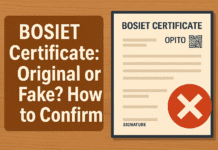
ISO 45001:2018 Occupational Health & Safety Management
ISO 45001:2018 Occupational Health & Safety Management : In today’s fast-paced world, ensuring the safety and well-being of employees is of paramount importance. Organizations across the globe are increasingly recognizing the significance of occupational health and safety management, and ISO 45001:2018 plays a central role in this endeavor. This article delves into the intricacies of ISO 45001:2018, its key components, benefits, and how it contributes to creating safer workplaces.
Introduction
The safety of employees in the workplace is a non-negotiable aspect of running any successful organization. ISO 45001:2018, the International Organization for Standardization’s (ISO) standard for Occupational Health and Safety Management Systems, sets the benchmark for ensuring the well-being of workers.
Understanding ISO 45001:2018
What is ISO 45001?
ISO 45001 is an internationally recognized standard that provides a framework for organizations to manage and improve their occupational health and safety performance. It is designed to help organizations prevent work-related injuries, illnesses, and fatalities while also ensuring compliance with relevant laws and regulations.
History and Evolution
ISO 45001 evolved from OHSAS 18001, a British standard for occupational health and safety management. The transition to ISO 45001 brought about a global perspective, making it applicable to organizations worldwide.
Scope and Applicability
ISO 45001 is not limited to any specific industry or sector. It can be implemented by organizations of all sizes and types, from manufacturing plants to service providers, aiming to enhance their safety performance.
Key Requirements of ISO 45001:2018
To achieve ISO 45001 certification, organizations must meet several key requirements:
Leadership and Commitment
Top management must demonstrate active involvement and commitment to the safety management system.
Policy and Objectives
Organizations should establish an occupational health and safety policy and set clear objectives and targets to continually improve safety performance.
Planning and Hazard Identification
Identifying and assessing workplace hazards is crucial for developing effective safety plans and controls.
Operational Controls
Implementing measures to control risks and hazards, such as safe work procedures and emergency response plans, is essential.
Performance Evaluation
Regular performance monitoring and evaluation ensure that safety goals are being met and that improvements are made when necessary.
Improvement
Organizations should actively seek opportunities for improvement and take corrective actions when incidents or non-conformities occur.
Benefits of ISO 45001:2018
Implementing ISO 45001 offers a multitude of benefits, including:
Enhanced Safety Culture
ISO 45001 fosters a culture of safety within the organization, where employees are actively involved in identifying and mitigating risks.
Legal Compliance
Compliance with legal and regulatory requirements is streamlined, reducing the risk of fines and penalties.
Reduced Incidents
The standard’s systematic approach leads to a decrease in workplace accidents and illnesses.
Employee Morale
Safe workplaces boost employee morale and job satisfaction.
Competitive Advantage
ISO 45001 certification can be a differentiator in the marketplace, attracting customers who prioritize safety.
Implementing ISO 45001:2018
Gap Analysis
Start by assessing your current safety practices against ISO 45001 requirements to identify gaps.
Documentation
Create and maintain comprehensive documentation of your safety management system.
Training and Awareness
Ensure that all employees are trained and aware of their roles in maintaining a safe workplace.
Internal Auditing
Regular internal audits help identify areas for improvement and ensure ongoing compliance.
Certification
Seek certification from accredited bodies to demonstrate your commitment to safety.
Challenges and Solutions
Implementing ISO 45001 may present challenges, such as resistance to change and resource allocation. However, these can be overcome through effective communication and dedicated resources.
Future Trends in Occupational Health & Safety
As technology continues to advance, the integration of smart safety systems and a focus on sustainability are expected to shape the future of occupational health and safety.
Conclusion
ISO 45001:2018 is a game-changer in ensuring occupational health and safety. It empowers organizations to create safer workplaces, protect employees, and gain a competitive edge in the market. By adhering to this standard, businesses not only meet legal requirements but also demonstrate their commitment to the well-being of their most valuable asset—their workforce.
ISO 14001:2015 Environmental Management
ISO 9001:2015 Quality Management
OSHA Standards: A Guide to Health and Safety Compliance
A Comprehensive Guide to OSHA Standards
OSHA Requirements for Employers
FAQs
- What is ISO 45001:2018? ISO 45001:2018 is an international standard for Occupational Health and Safety Management Systems that provides a framework for organizations to manage and improve their safety performance.
- Why is ISO 45001 important for businesses? ISO 45001 is crucial for businesses as it helps prevent work-related injuries and illnesses, ensures legal compliance, and enhances employee morale, all of which contribute to long-term success.
- How can ISO 45001 benefit employees? ISO 45001 benefits employees by creating a safer work environment, reducing the risk of accidents, and promoting a culture of safety and well-being.
- Are there any downsides to implementing ISO 45001? While the benefits of ISO 45001 are substantial, some organizations may face challenges in terms of initial implementation costs and resistance to change. However, these can be overcome with proper planning and commitment.
- Is ISO 45001 applicable to all industries? Yes, ISO 45001 is applicable to organizations of all sizes and types, regardless of their industry or sector, making it a versatile standard for improving safety across various fields.
























